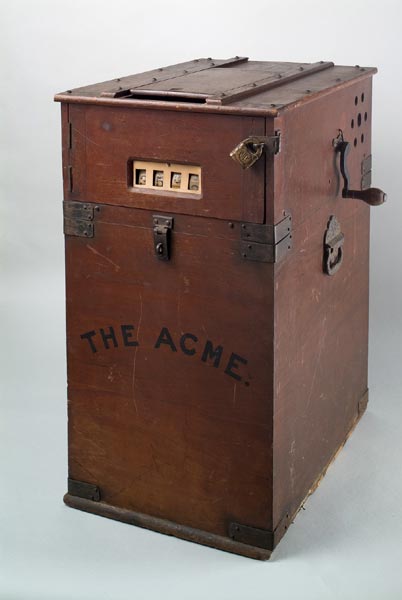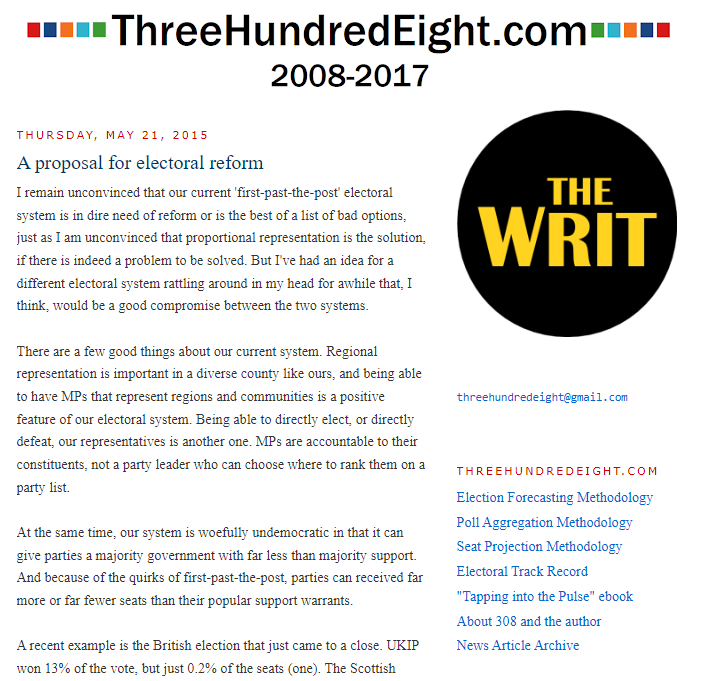
Voting pre-supposes an informed electorate.
Okay, now that we’ve wiped the tears away and stopped laughing, if we’re still going to have voting, let’s talk about voting systems. I’ll be writing from a Canadian perspective, of course.
First, there’s what we have now, FPTP. As soon as there are more than two viable options, it falls apart. You typically get minority rule – the last Canadian election where the winning party got more than 50% of the popular vote was the 1984 Progressive Conservative victory under Brian Mulroney – and a lot of regionalism. The results won’t very well represent, for example, federalists in the Quebec hinterlands or liberals in rural Alberta. (Well, if there are any. Might have to check under a hay bale.)
An improvement, to my mind, is AV (also called IRV). Now you will still only have one winner per riding, and continuing from my previous example it will still be the Bloc in QC and the CPC in AB winning such ridings. Where it matters is the contested seats. AV supports winners who build consensus – the winner could be everyone’s second choice rather than a polarizing one that people who aren’t supporters distrust.
An improvement on top of that is STV. Now you can have five winners per riding. (You would, though, want to make the ridings somewhat larger, although if you really want to give PEI 20 MPs I won’t complain.) With multiple representatives, you have a good shot at electing one that you can approach. In a few special circumstances there might have to be three or even one representative (like with the territories, for example). In any case, you keep the ranking paradigm from AV.
Now I am happy with STV because I think political parties, if we have them at all, should be emergent, ideally from the people but also sometimes from representatives who find common cause over something significant. Indeed, if anything I would prefer nonpartisan assemblies, although I’ve never been to Nebraska or NWT or Nunavut and know little about their politics – which might be a good sign, if you think about it. Parties can wind up as much more than the sum of their membership and those elected under their banner. So for me a PR system is less appealing.
But, I think there might yet be a good PR system for Canada: Éric Grenier’s 308PR:

In 308PR, you vote the same way you do now, but instead of voting for the representative directly, what you are doing is creating each party’s list. Keep in mind, though, that the MPs would represent the provincial populaces more broadly and not necessarily just the ridings they were elected from. Grenier also provides a detailed look at how the 2011 vote would have been processed under this system.
In any case, what I would propose is this: First, establish an independent Royal Commission whose task is to design a very good STV system, a very good PR system (perhaps a variant of MMP, looking at examples such as New Zealand and Germany), and perhaps something else. Then those and FPTP go on to a multiple-choice referendum with an AV ballot. And for this purpose, AV is perfect. Because there really can only be one winner anyway!
But, in case something went horribly wrong, there would be a safety feature. We review the situation again after 10 years. We then have a straight yes / no vote:
- Keep the chosen system indefinitely
- Go back to the Royal Commission again, but don’t include this system among the choices without reforming it significantly
And the safety feature would also repeat once that is done. Indeed it could in theory go on forever, but I’m not expecting another Isner-Mahut here. This can’t be that hard of a problem to solve, if you can get it out from under the government of the day and give people good choices to choose from instead of di- or tri– or n-lemmas. Also, third-party advertising would be severely restricted, but advocates of the particular ideas would be allowed to craft presentations that would all be released on a specific date.

Senate Reform
While we’re here, I’ll bang out a quick plan for the Senate:
- Existing Senators retire out gradually at age 75, as they do already
- New Senators must be 50 years of age or older. (Residential ties to the region of appointment can be minimal if not downright ceremonial. If we really cared about representing the regions somehow, we’d have an elected Senate.)
- These Senators serve a single 10 year term, which can however continue past age 75, indeed they can even be appointed past 75 if it makes sense to do so (i.e., if they’re hale)
- Appointments are based on popular petitions, as openings come up. The people would probably tend to nominate popular figures, for example retired athletes, breakthrough-finding scientists, great Canadian authors, musicians, etc.. who are likely to be non-partisan. Nobody really runs for the Senate, indeed it would be considered crass. You either accept or decline the appointment
- You can be appointed for a second term should the people have a mind, but you have to have been out of federal politics entirely for five years after your first term ends
- The idea is to promote sober second thought, not to get too much into the weeds of drafting legislation, although anything other than a money bill can still in theory start in the Senate if the cause is important enough and the government isn’t responsive
- Minimum time commitment is minimized compared to service in the House, inasmuch as the Great tend to go on with their life’s work until they can’t anymore. In fact, they can have trusted associates sit on committees on their behalf (without voting, but they may speak) and report back to the Senator, who would perform the actual floor vote after having consulted with the associate and thinking things over
Well, I guess I can’t run for the NDP now, as they are for Senate abolishment. There goes my political career!
Approval Voting
This is a good system to use in low-stakes, among-friends cases. Basically you just ask what you’re good with, rather than the favourite – the trick is that you can vote for more than one thing. And then the most votes wins!